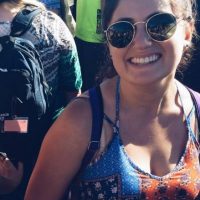
“Lo alecha hamlacha ligmor, v’lo atah ben chorin l’hivatel mimena”
Emily Brown | California
Originally from Los Angeles, Emily is a proud Ramah in California alum, having spent many summers at camp both as a chanicha and madricha. While on tzevet, Emily focused on challenging traditional gender roles and supporting her chanichot to empower themselves, as well as creating inclusive programming for LGBTQ campers. Currently, Emily works as an epidemiology research assistant at Fenway Health in Boston, MA.
Pinned above a hand-made “Have a LIT Hanukkah” card, sits a pale-yellow sticky note on my desk. Lost amongst the Keshet Safe Zone stickers, rupi kaur poetry and HIV medication infographics, my little sticky note reminds me not only of my responsibility to the world, but also of the intentionality and ethics of my Jewish community: “Lo alecha hamlacha ligmor, v’lo atah ben chorin l’hivatel mimena.”
It is not incumbent upon you to complete the work, but neither are you at liberty to desist from it.
Shortly after graduating from Washington University in St. Louis with a degree in Women, Gender and Sexuality Studies, I moved to Boston, where I began working as a research assistant at The Fenway Institute (TFI) at Fenway Health. Emerging in the early days of the AIDS epidemic, Fenway Health provides competent and comprehensive care for the Northeast’s LGBTQ communities, consisting of primary care, pediatrics, optometry, behavioral healthcare, dentistry, and sexual health education. Within TFI, we conduct research that specifically addresses LGBTQ healthcare gaps and needs, giving light to generally ignored health issues. My study, in particular, examines the impact of couples HIV testing and counseling on male couples, made up of one HIV-positive partner and one HIV-negative partner. Through these counseling sessions, I’ve heard stories about the consequences of when we do nothing in the face of fear, confusion and devastation. They’ve told narratives of lost loved ones, disapproving parents and a vanished generation of young, vibrant men.
Today, however, through scientific progress, people living with HIV can live long and fulfilling lives — but only if they can afford the medication.
HIV is a virus that disproportionally impacts LGBTQ folks and people of color. While we have adequate medication to treat HIV, the issue lies within access to care. Those who cannot afford HIV medication or who do not have access to transportation are left to suffer from a chronic, yet treatable, illness. The question is no longer how do we treat HIV, but rather, how do we get treatment to those who need it?
How do we, as Jews and as Ramahniks, reconcile health inequity? How do we, as Jews and as Ramahniks, address pervasive practices that leave communities marginalized? If we, as dugmaot for our chanichim, advocate for inclusivity – even in a moment as small as choosing bunks – we must advocate for equity in the big picture as well.
I look to the early Jewish HIV/AIDS activists for inspiration and wisdom: the bold and loud Larry Kramer, the courageous and loving founders of Beit Chayim Chadashim and Project Chicken Soup in Los Angeles and the eloquent and articulate Tony Kushner and William Hoffman. I think of their strength, I think of their fight and it reminds me that our task, while it may not be completed in my lifetime, is far from done.
